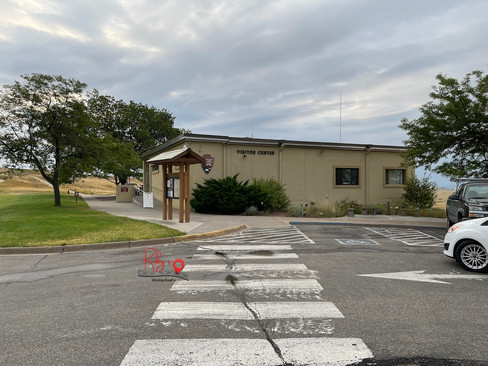Surrounded In Battlefield History
- Ruby's Winding Road

- Aug 12, 2023
- 7 min read
As tweens and teens, we remember sitting in history class learning about this and that related to U.S. History. Our teachers would present lectures about places we had not seen and struggles we didn't have the maturity to fully understand. To us it was just 50 minutes in the day to listen, jot a few notes, and maybe watch a film strip before lunch. From there we'd head off to the cafeteria for a piece of chewy pizza that fit perfectly into the rectangle section of the tray in which it was served. A plop of chocolate pudding, spoonful of green beans, some fruit cocktail and a carton of milk filled out the rest of the tray. History class? Oh, yeah. There's a chapter quiz on Friday.

Occasionally, there'd be that teacher. The one so passionate about significant historical events that he or she would break free from the normal dry lecture and try to share history in the form of relatable stories with us kids. That teacher was also likely to be the basketball coach (or something along those lines) and would run back and forth in front of the class as if on the sidelines of a coaching gig. With arms flailing in the air and voice filled with emotion, that teacher tried to keep us engaged in our learning. And, for good reason. There was something to be learned, internalized and remembered long after the completion of that Friday chapter quiz.
As we pulled into the Little Bighorn Battlefield National Monument in southeastern Montana, recollections of one of those animated teachers came to mind. In this blog post we'll just call him Coach H.
Coach H wasn't the U.S. History teacher at school. He taught Government. He also happened to be an athletic coach. He took the messy dates, definitions and timelines from other dry history classes and weaved them into something that made sense to us about our government in that moment. Coach H helped us to understand that the battles and events of the past should be remembered. He stressed that they are the building blocks to the nation we have today. Coach H taught us kids that it was our responsibility to learn about the sacrifices made in the development of our country. He was right. That was all the more apparent during our visit to the historic battlefield.
There was a heaviness felt during our visit to the Little Bighorn Battlefield National Monument. Thunderstorms had rolled through just before our arrival and the wet ground below our feet and dark clouds hovering above us only seemed to add to the somberness of the park. Our visit was an opportunity to pause and reflect on what happened here and why. Strangely, Coach H popped to mind as if he were with us on our journey through the park.
Located just beyond the park entrance gate is Custer National Cemetery. Rows of perfectly aligned tombstones are placed marking the final resting area for those who served our country. The cemetery was established by the War Department in 1879, shortly after the Battle of Little Bighorn. Soldiers from other wars, including World Wars I and II, are buried in this national cemetery. Burial reservations continued to be accepted until 1978.

To walk or drive further past the national cemetery is to stand in the area of one of the most notable battles of the Great Sioux War of 1876; the Battle of Little Bighorn. It was here on June 25, 1876 that Lt. Col. George Armstrong Custer and his 7th U.S. Cavalry were defeated in a battle known as Custer's Last Stand. It is here that the remains of about 220 soldiers, scouts and civilians from the battle are buried in a single grave site. It is here that a sacred Indian Memorial was constructed to honor Native Americans who fought to preserve their way of life.
The Battle of Little Bighorn occurred after Native American tribes missed a federal deadline to move to reservations after gold had been discovered on land they occupied. Sitting Bull and other Lakota leaders rejected the reservation system and came together in their resistance. Lt. Col. Custer was sent to confront the tribes. Custer divided his command, however, greatly underestimating the numbers of warriors his 7th U.S. Cavalry would encounter as they moved toward the Little Bighorn Valley and the Native American encampment.
In the end, Custer's soldiers were overwhelmed by thousands of Lakota, Arapaho, and Cheyenne warriors who had banded together to fight. It was Custer's Last Stand.

There's a sadness you feel standing in this former battlefield location. With the beauty of the rolling northern plains as a backdrop, display boards at the location illustrate the horror of the fight. Marble headstones scattered across the amber-colored field, some peeking out from the tall grasses, signal that a soldier fell at that exact location during battle. It is a strikingly eerie representation of war.
It was easy for our senses to feel conflicted while surrounded in battlefield history. The sounds of pretty grasses rustling in the wind, along with an occasional pitter patter of rain were somewhat calming. Though, it took little to envision the fighting, pain, strength and suffering that occurred here.
Research in the area has uncovered many items you'd expect to be discovered on a battlefield such as weapons and equipment. Then there are the emotional archaeological finds like clothing buttons from Cavalry uniforms and even a wedding band still in place on a finger bone of a Cavalry soldier.

Cavalry soldiers were quickly buried in the days following the battle, but were later moved and reburied in a single site at the base of a monument on the battlefield. Officers' remains were moved to other cemeteries along the east coast and Lt. Col. Custer's remains were reburied at West Point, NY.
In 1890, 249 of those ghostly white marble headstones were placed across the battlefield to mark locations where military bodies, including that of Custer, were found. Custer's marker has a black background behind the stone's lettering to better highlight his name. Dozens of horses from the 7th Cavalry lost in battle were not forgotten by the military. They are also buried in a marked mass grave.
A circular-shaped Indian Memorial in the theme, "Peace Through Unity", commemorates sacrifices of Native American tribes that fought in the Battle of Little Bighorn. The memorial was added years later after Native Americans protested the need for recognition in the history of the battle.

The Indian Memorial design represents the past, present and future. It was dedicated in 2003 and finally completed in 2013. The Indian Memorial is a deeply thought-provoking monument engraved with quotes and pictures. The circular memorial surrounds you with the emotions of the tribes involved in the design. The memorial incorporates the natural landscape into the background of a bronze sculpture of warriors heading into battle.
The 7th U.S. Cavalry Memorial marker on Last Stand Hill can be seen from the center of the circular Indian Memorial. This opening is a Spirit Gate to allow for cavalry dead to enter the circle and proceed into the afterlife. The Spirit Gate is meant to support the theme of "Peace Through Unity".
From outside the circle, the memorial blends discreetly into the natural rolling hills surrounding it. There are also nearby markers for individual Native American warriors who died in battle. Those were erected by the National Park Service beginning in 1999.
The Little Bighorn Battlefield National Monument is located on the Crow Indian Reservation and near the Little Bighorn River. After you pay park entrance fees and proceed through the park gates, be sure to stop at the Visitor Center. There are museum exhibits and information available to help guide you through your visit. Be sure to pick up a map with descriptions of key park areas. The park provides resources for self-guided-walking tours, as well as a 4.5-mile driving tour.
In addition to the Custer National Cemetery, locations to visit include the area of the Indian Encampment where thousands of Native Americans were located; Custer's Advance where Custer divided his command to strike the encampment; Sharpshooter Ridge where Custer watched as his second in command, Maj. Marcus Reno, was attacked with his soldiers; and Last Stand Hill where Custer lost his life.

The National Park Service does remind visitors that the national monument and cemetery are areas to be treated with respect. No camping or picnicking is allowed in the park. If your pet travels with you like ours does, it's important to know that pets are not allowed outside of the vehicle in most areas here. As we drove through and stopped at various viewing locations, we each took turns exploring outside the vehicle while the other remained in the RV with our pup. If your pet needs a break, there is one designated area near the park entrance.
Our visit to the Little Bighorn Battlefield National Monument was deeply moving. It's not a visit we can easily get out of our thoughts; nor should we. That's what Coach H was trying to help us understand. Hopefully, everyone is fortunate enough to have a Coach H in school to help puzzle together pieces of history in a meaningful way. It's with that base of information we learn how our nation developed. Visits to important historic sites such as this one help us gain an even deeper personal perspective for our nation's history. We recommend also visiting Fort Abraham Lincoln State Park in Mandan, North Dakota. It's from that location that members of the 7th U.S. Cavalry left for the Battle of Little Bighorn. You can read about our visit to that site at RubysWindingRoad.com.
The Battle of Little Bighorn National Monument is open daily with a few holiday exceptions. For more information about the monument visit www.nps.gov.
Thanks for taking time to read our blog. Check out RubysWindingRoad.com for past blog posts and photos. You can also subscribe so you don't miss a post.



























Comments